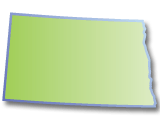North Dakota Rebates and Incentives Summary
 North Dakota has a population of just under 650,000, according to the U.S. Energy Information Administration (EIA), a small population for a state of its size, considering Colorado has a population of roughly five million. Because of its small population, North Dakota is one of the nation’s lowest energy consumers, ranking 46th in the nation. Although per capita, its citizens consume at one of the highest rates in the country, largely due to the extreme cold temperatures the state is subjected to during the winter months.
North Dakota has a population of just under 650,000, according to the U.S. Energy Information Administration (EIA), a small population for a state of its size, considering Colorado has a population of roughly five million. Because of its small population, North Dakota is one of the nation’s lowest energy consumers, ranking 46th in the nation. Although per capita, its citizens consume at one of the highest rates in the country, largely due to the extreme cold temperatures the state is subjected to during the winter months.
In 2005, 95 percent of North Dakota’s fuel for electricity came from coal, with only 1 percent coming from renewable energy sources like wind and solar.
Though North Dakota currently relies almost entirely on coal-fired power plants for its electricity needs, it is a state rich with renewable energy potential. Not surprisingly, for a state boasting 68,975 square miles of mostly open land, North Dakota’s primary renewable energy source is wind power. Still, the state has incentives for people interested in incorporating not just wind energy, but also solar, and geothermal energy devices into their homes and businesses.
North Dakota has a lot of room for improvement in the area of renewable energy, which Governor John Hoeven said he was determined to promote in his 2007 State of the State address: “Today, many states are adopting a goal to derive 25 percent of our nation's energy from renewables by 2025. We can achieve that...”
In fact, North Dakota more than doubled its generation of energy derived from renewable sources between 2004 and 2006, contributing a total of 413 million kilowatt hours (kWh) to their overall energy production—403 million of which came from wind power. Considering the average U.S. household consumes about 11,000 kWh per year, North Dakota was able to power 41,300 homes using renewable energy in 2006.
In addition to having a renewable portfolio standard in place, the state plans to increase its installed capacity for wind generation to 5,000 megawatts by 2020, under the EmPower North Dakota Commission. To that end, the state is offering three million dollars' worth of tradable income tax credits for the installation of geothermal, solar, and wind energy devices, creating a variety of incentives for the use and production of renewable energy. These include property-tax reductions or exemptions, tax credits, and rebates.
